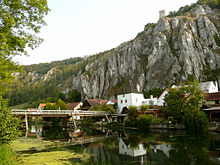Altmühl
This articleneeds additional citations forverification.(March 2016) |
| Altmühl | |
|---|---|
 The Altmühl as part of the Main-Donau-Kanal near Riedenburg | |
 Map with the Altmühl highlighted | |
| Location | |
| Country | Germany |
| Physical characteristics | |
| Source | |
| • location | Middle Franconia |
| Mouth | |
• location | DanubeatKelheim |
• coordinates | 48°54′37″N11°54′25″E/ 48.91028°N 11.90694°E |
| Length | 226.9 km (141.0 mi)[1] |
| Basin size | 3,258 km2(1,258 sq mi)[1] |
| Discharge | |
| • average | 24.3 m3/s (860 cu ft/s) |
| Basin features | |
| Progression | Danube→Black Sea |
TheAltmühl(German pronunciation:[ˈaltˌmyːl],Latin:Alchmona, Alcmana, Almonus)[2]is a river inBavaria,Germany.It is a left tributary of the riverDanubeand is approximately 230 kilometres (140 mi) long.
Course
[edit]
The source of the Altmühl is close to the town ofAnsbach.From here the river runs southeastwards as a narrow brook to enter theAltmühlsee(a lake) north ofGunzenhausen.After leaving Gunzenhausen, the river moves in a broad curve through theFranconian Jura.It enters theNaturpark Altmühltal(Altmühl Valley Nature Park), which is known for its natural environment: Themeandersof the Altmühl river have cut deep gorges into the mountains of the Franconian Jura.
The Altmühl passes the towns ofTreuchtlingen,EichstättandBeilngries.
Downstream ofDietfurt,the riverbed was straightened and integrated into a canal connecting theriver Mainand the river Danube (theRhine–Main–Danube Canal). In spite of protests by conservationists, the canal was opened in 1992 and has changed much of the eastern Altmühl valley.[3]
The Altmühl finally flows into the Danube inKelheim.
River
[edit]
The Altmühl rises on the southern slope of the Franconian Ridge northeast ofRothenburg ob der Tauber,near the Hohe Leite and about 500m southeast of theBurgbernheimwilderness Wildbad. As its source, theRoyal Bavarian Hydrotechnical BureauatMunichin 1904 fixed thedrainageditch ofHornauer Weiher.This is fed by some streams; in the meantime the source of one of them is regarded as Altmühl origin. The Altmühl therefore rises just south of the majorEuropean watershedand then flows mainly in southeastern direction. It is the slowest river in Bavaria, flows very slowly, is even one of the slowest German rivers and is also the longest river that rises and flows in the same German state.
The Altmühl can be divided into three parts.
In the upper third, it is ameadowriverslowly flowing in abroadvalley.Thelandscapeis flat, slightly hilly and the ground consists mainly of rocks of theKeuperperiod, here mainlylimestoneandclay.The mudstone seals thesubsoil,therefore, the Altmühl in its upper reaches is a not-too-broadstream.
In its middle course flows the Altmühl in the north and east on Altmühlsee atGunzenhausenover. Theriverbedwas rebuilt here during theconstructionof the Altmühlsee in the 1980s. On the southern shore of the Altmühlsee, the course of the river crosses the Altmühlüberleiter underground.
Only at times of high water discharge does water flow from the Altmühl over the Altmühlzuleiter into the Altmühlsee, which was created as a reservoir to divert water from the Altmühl to the drier river system of theRegnitz.Thislakeis designated as abirdandnature reserve.The water taken from the lake flows through a tunnel to theBrombach reservoirs,drained by theBrombach(Regnitz basin), north of thecontinental divide.The water of the Regnitz flows finally over the Main into theRhine,so that with the transfer anartificialriverbifurcation was created.
FromTreuchtlingenthe Altmühl flows in its lower course through the Franconian Jura plateau, in whose karst limestone it has dug a narrow valley. On the steep valley slopes here sometimes bizarrerock formations,for instance the cauldron shaped washouts near the village Eßlingen, about 20m above theriver level.
From Dollnstein the Jura Breakthrough Valley suddenly becomes much wider. From here the Altmühl flows through an earlier valley of the largerDanube.AtRennertshofenthis "Urdonautal" branches off from the present Danube valley; in the section where not the Altmühl flows in it, but only small brooks, it is calledWellheimdry valley.
From the year 1910 the course of the river downstream fromUnterwurmbachwas straightened and regulated with numerousweirs,hence many oxbow lakes were cut off. Since then, some of the regulatory measures have been reversed, for instance nearTreuchtlingen-Graben and shortly beforeEichstättat Wasserzell.
Its lowermost course fromDietfurtwas expanded in the middle of the 19th century with 10locksto become a part of theLudwig-Danube-Main Canal.The same route was used from 1975 to 1991 for the construction of theRhine–Main–Danube Canal,a major shipping route with locks inRiedenburgand Kelheim. For the first time in a waterway construction project in Europe, landscaping plans for ecological measures were set up in order to replace nature and landscape interventions; 15% of the canal construction costs were spent on this. The Altmühl flows into theDanubebelowKelheimat Danube kilometers 2411.54. The about 34 kilometers long Altmühl section is included in thefederal waterwayMain-Danube Canal; In addition, the 580 meters of Altmühl above the weirDietfurtto the MDK are a federal waterway.
Along the Altmühl runs the well-marked and quite well furnishedAltmühltalradweg.Canoeing can be done safely on the river itself.
See also
[edit]References
[edit]- ^abComplete table of the Bavarian Waterbody Registerby the Bavarian State Office for the Environment (xls, 10.3 MB)
- ^Orbis Latinus,s.v.
- ^Fischer, Ralf (30 July 2012)."20 Jahre geflutet: Der ewig umstrittene Main-Donau-Kanal (German)".Bayerischer Rundfunk.
External links
[edit]![]() Media related toAltmühlat Wikimedia Commons
Media related toAltmühlat Wikimedia Commons
